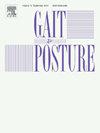Comparative analysis of gait domains in middle-aged and older adults under single- and dual-task conditions
IF 2.2
3区 医学
Q3 NEUROSCIENCES
引用次数: 0
Abstract
Background
Dual-task gaits are linked to falls in older individuals, but their underlying structure is unknown compared to single-task gaits. We employed principal component analysis (PCA) to discover independent domains underlying single- and dual-task gaits in cognitively healthy community-dwelling people over 45.
Methods
One hundred eighty-nine independent individuals (aged 45–80) completed health surveys, physical and cognitive tests, and walking evaluations under single-task, motor dual-task, and cognitive dual-task conditions. We applied PCA to 17 spatiotemporal gait parameters to identify independent domains for each gait. Logistic regression analyses were conducted to determine demographic, physical, and cognitive characteristics associated with domain scores.
Results
The results revealed six independent domains consistent across all three gait types: rhythm, variability, phase, pace, base of support (BOS), and asymmetry. These domains accounted for 77.2–83.8 % of the overall gait variance. Rhythm, variability, and phase were the top three domains for all three gait types. Pace was the fourth domain for single- and motor dual-task gaits, while asymmetry held this position for the cognitive dual-task gait. In all three gaits, male sex and heavier weight were associated with greater BOS scores. Taller height and shorter five-times-sit-to-stand test (5XSST) time were associated with greater pace scores, while heavier weight was additionally linked to greater phase scores (p < 0.05). Notably, greater variability domain scores in the cognitive dual-task gait were uniquely associated with poorer executive function, balance, and shorter 5XSST time (p < 0.05).
Significance
PCA results revealed consistent gait domains across single-, dual-, and cognitive dual-task conditions in older adults. These findings support the feasibility of using standardized, streamlined assessments focusing on these core domains in geriatric gait assessments. Findings of the unique cognitive dual-task gait characteristics highlight the importance of assessing gait variability and asymmetry of this gait for fall risk screening and prevention interventions.
求助全文
约1分钟内获得全文
求助全文
来源期刊

Gait & posture
医学-神经科学
CiteScore
4.70
自引率
12.50%
发文量
616
审稿时长
6 months
期刊介绍:
Gait & Posture is a vehicle for the publication of up-to-date basic and clinical research on all aspects of locomotion and balance.
The topics covered include: Techniques for the measurement of gait and posture, and the standardization of results presentation; Studies of normal and pathological gait; Treatment of gait and postural abnormalities; Biomechanical and theoretical approaches to gait and posture; Mathematical models of joint and muscle mechanics; Neurological and musculoskeletal function in gait and posture; The evolution of upright posture and bipedal locomotion; Adaptations of carrying loads, walking on uneven surfaces, climbing stairs etc; spinal biomechanics only if they are directly related to gait and/or posture and are of general interest to our readers; The effect of aging and development on gait and posture; Psychological and cultural aspects of gait; Patient education.
 求助内容:
求助内容: 应助结果提醒方式:
应助结果提醒方式:


